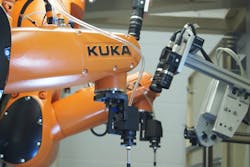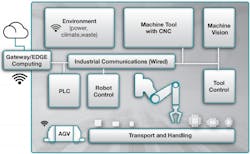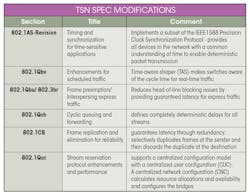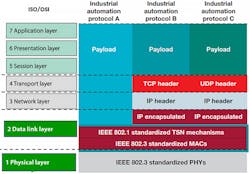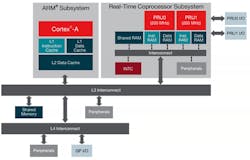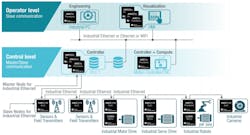Download this article in PDF format.
Industrial robots date back over 50 years to 1961, when GM began using Unimation robots for material handling and spot welding. Ever since, robots have played an ever-increasing role on the factory floor. In addition to the jobs described, they’re also used in painting, assembly, component pick-and-place in printed-circuit boards (PCBs), packaging, product inspection, and testing.
Robots boost productivity, provide more consistent quality in repetitive tasks, and improve worker safety. The latest generation of robots are adding enhancements such as machine vision (Fig. 1). These provide great application flexibility that pays off in reduced investment, more efficient production runs, and a wider range of manufacturing options.
Sponsored Resources:
- Industrial Robot Communication Module
- High EMC Immunity RS485 Interface Reference Design for Tamagawa Encoders
- Time sensitive networking for industrial automation
1. By adding features such as machine vision, industrial robots are ramping up the demands placed on industrial networks (Source: Abraham Innovation Systems)
But adding these advanced features has an associated cost: They produce prodigious amounts of data and increase the strain on the factory network infrastructure.
In all aspects of factory operation, the Internet of Things (IoT), digital twinning, and data mining have greatly improved quality and reduced downtime through such innovations as predictive analytics (Fig. 2). This in turn has led to an explosion in the amount of data that must be transferred between individual factory nodes, such as CNC machines and robot work cells, and between the factory and the cloud.
2. A current-generation automated factory uses wired and wireless networks to maximize production efficiencies and provide real-time feedback for cloud-based data mining. (Source: TI: “Time-sensitive networking for industrial automation” PDF, p. 3)
Control is a Hierarchy
An automated industrial system requires a distributed hierarchical control system (Fig. 3) in which each level of control is appropriately sized for the task at hand. The decision-makers at the enterprise level occupy the top level of the hierarchy. Below that, there’s a fieldbus level that interconnects a middle layer of programmable-logic controllers (PLCs). The lower levels connect the PLCs to the end-node components such as sensors, actuators, valves, motors, switches, and so on.
3. The automated factory requires a varied mix of communication schemes. (Source: TI: “Selecting the right industrial communications standard for sensors” PDF)
The simplest level of control doesn’t require a network at all. At this level, the communication scheme is via a discrete input/output (I/O) port from a PLC. The I/O signal can be digital or analog in nature. Temperature sensors, for example, typically generate an analog voltage, and a proximity switch might be on/off. Installing a new sensor or actuator requires a manual operation, and the PLC must handle any diagnostics and report any faults.
The intermediate level consists of point-to-point communication in a master-slave arrangement. IO-Link (IEC 61131-9), for example, is an open standards protocol for intelligent control of small devices. It provides low-speed point-to-point serial communication between a device and a master that normally serves as a gateway to the higher-level network. The intelligent link enables ease of communication for data exchange, configuration, and diagnostics.
Ethernet Tightens Its Grip on the Factory Floor
The next higher level connects robot work cells, PLCs, and other similar nodes in a factory-wide fieldbus network. It also connects to a gateway, and thence to the cloud.
Fieldbus is the generic name of a set of industrial computer network protocols that are defined in IEC 61158. Although many fieldbus protocols exist, such as controller area network (CAN) and simple sensor interface (SSI), some variant of Ethernet is slowly becoming dominant in factory automation.
Standard Ethernet is cost-effective, with a common physical layer and high speeds. The protocol allows for a flexible network topology and a flexible number of nodes, but Ethernet is non-deterministic. The delay between a message leaving its origin and arriving at its destination is variable, and can be up to 100 ms.
A deterministic network—one in no random variations in propagation times occur between messages—is important for automated applications. As a result, industrial Ethernet protocols with deterministic data delivery have been developed for use on the factory floor.
Industrial Ethernet isn’t a single unique specification, but a group of differing protocol implementations driven by various industrial equipment manufacturers. Popular protocols include PROFINET, EtherCAT, Ethernet/IP, Sercos III, and CC-Link IE Field. They offer high bandwidth, long physical connections, low latency, and deterministic operation, among other features.
TSN Extends Ethernet for Real-Time Applications
In addition to deterministic operation, guaranteed latency is a critical requirement for industrial real-time control applications.
Time-sensitive networking (TSN) adds this real-time functionality to standard Ethernet. TSN is an Ethernet extension defined by the Institute of Electrical and Electronic Engineers (IEEE) aimed at addressing determinism and quality of service without compromising the strengths of Ethernet such as interoperability.
There are several sections of the TSN specification, not all of which have been fully implemented. The table provides an overview of the TSN modifications; go here for a detailed description.
TSN is a local-area-network (LAN)-level solution that can work with non-TSN Ethernet, but timeliness is only guaranteed inside the TSN LAN. Ethernet operates at the lowest two layers of the OSI model—the Data Link layer and the Physical layer. TSN modifies the OSI Data link layer (Fig. 4), but applications will still require an upper-layer protocol such as UDP/IP or PROFINET.
4. TSN adds real-time capabilities to standard Ethernet by modifying the data link layer of the OSI model. (Source: TI: “Time-sensitive networking for industrial automation” PDF, p. 4 and 6)
Leading industrial Ethernet organizations are adopting TSN technology and integrating it into existing engineering systems and application profiles. Higher-layer control systems and other applications outside the factory may also work with central network configuration tools independent of the application.
One advantage of TSN is that it’s scalable, so it supports 100 Mb, Gb, and higher transfer rates. This feature allows the optimization of data rates for different segments while keeping the same layer 2 implementation.
Hardware Implementations of Industrial Ethernet and TSN: TI’s Sitara and PRU-ICSS
Updating to a new protocol such as TSN is desirable, but the hardware for a real-time control application must meet its requirement for guaranteed latency. Many general-purpose processors (GPPs), though, can’t guarantee a response time that meets these strict constraints, no matter how high their baseline performance.
The reason? Many GPP features, such as instruction pipelines and memory and interconnect architectures, are designed to boost the core’s effectiveness in running a high-level operating system (HLOS). But these same features can reduce the GPP’s suitability for time-critical real-time applications.
For example, the GPP core may interface to several types of memory—internal, external, shared—or interface to the I/O ports through several interconnect layers. Each one can slow down the response and add a degree of unpredictability. The result is that the response to a real-time event will likely vary each time the event occurs.
Adding an external ASIC or FPGA to handle real-time operations is one option, but a system-on-chip (SoC) device can integrate a specialized co-processor subsystem to overcome the limitations of the standard architecture. TI's Arm processors feature a unique module, called the Programmable Realtime Unit Industrial Communications Subsystem (PRU-ICSS), which enables the integration of real-time industrial communication protocols and eliminates the need for an external device.
5. A general-purpose core supplemented with specialized co-processors is needed for real-time operations. (Source: TI: “Ensuring real-time predictability—Leveraging TI’s Sitara processors programmable real-time unit” PDF, p. 3)
Each PRU subsystem (Fig. 5) consists of two 200-MHz real-time cores, each with a 5-ns cycle time per instruction. Since the real-time cores aren’t equipped with an instruction pipeline, single-cycle instruction execution is ensured. The PRU’s small, deterministic instruction set with multiple bit-manipulation instructions is easy to learn and use.
The PRU architecture gives the SoC direct and fast access to the outside world since each PRU has its own single-cycle I/O. In addition, local memory and peripherals dedicated to each real-time engine means that each unit can guarantee low-latency responsiveness. An incoming interrupt can access a real-time processing engine directly without encountering the delays caused by crossing the several layers of interconnects and memory in the GPP.
The PRU is deployed along with ARM cores in the TI’s Sitara family of SoCs: the AM335x, AM437x, AM5x processors, and AMIC110. These devices provide scalable solutions for a wide range of industrial applications as well as support for multiple industrial communication protocols.
To assist in development, TI offers the PRU-ICSS Protocols for Sitara processors. These are built to use on top of Processor-SDK-RTOS, TI’s unified software development platform, and include optimized firmware, a driver for the selected ARM processor, and example applications.
Multiple Ethernet, fieldbus, interface, and redundancy protocols are offered at no charge, including certified solutions for EtherCAT, Profibus, and PROFINET. The PRU-ICSS can support multiple protocols on the same hardware using firmware supplied by TI, through the Industrial Software Development Kit, or from industry partners.
Figure 6 shows the PRU used to process the Ethernet protocols in an industrial automation application. The AMIC110 Industrial Communications Engine (ICE) is a development platform targeted at industrial communications and industrial Ethernet. The AMIC110 ICE features the ARM Cortex-A8 processor and the PRU-ICSS. In this application, the AMIC110 is paired with the C2000, a 32-bit microcontroller that’s optimized for industrial closed-loop motor control in servo drives and robots.
6. The AMIC100 can support numerous industrial Ethernet use cases. (Source: TI: “Ensuring real-time predictability—Leveraging TI’s Sitara processors programmable real-time unit” PDF, p. 6)
Conclusion
Industrial robots are a key part of the move to fully automated, flexible factories, which will reap benefits for manufacturers and consumers alike. But the move to tighter control forces changes to the traditional networking infrastructure.
Deterministic systems and time-sensitive networking are two elements that accommodate these new realities. Texas Instruments’ Sitara family of MCUs and SoCs are designed to meet new and emerging networking requirements.
Sponsored Resources:

